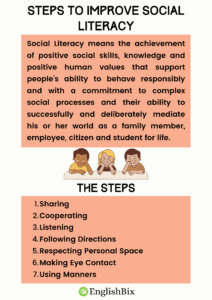Social Literacy means the achievement of positive social skills, knowledge and positive human values ??that support people’s ability to behave responsibly and with a commitment to complex social processes and their ability to successfully and deliberately mediate his or her world as a family member, employee, citizen and student for life.
Steps to Improve Social Literacy
Following are some examples of steps to improve social literacy in kids.
1. Sharing
Children between the ages of three and six are often self-centered when it comes to sharing expensive resources. By the age of seven or eight, children are more concerned about righteousness and are more likely to be involved.
Praise your child for sharing and show how it makes others feel. Say something like, “You have chosen to share your meal with your sister. I bet he feels happy about that. That’s a good thing to do.
2. Cooperating
Teamwork means working together to achieve a common goal. Children who work together are respectful when others make requests.
For children, collaboration can involve anything from building a toy tower together to playing a game that requires everyone to participate.
Create opportunities for the whole family to work together.
3. Listening
Listening isn’t just about being quiet – it means really absorbing what someone else is saying. Listening is also an important part of healthy communication.
Giving your child plenty of opportunities to practice listening can strengthen this ability.
4. Following Directions
Kids who struggle to follow directions are likely to experience a variety of consequences.
- Don’t give a young child more than one direction at a time.
- Don’t phrase your directions as a question
- Don’t forget that mistakes are normal
5. Respecting Personal Space
It is important to teach children how to respect the personal space of others. Create home rules that encourage children to respect other people’s private space. “You knock on doors,” and “Keep your hands to yourself,” are just a few examples.
6. Making Eye Contact
Good eye contact is an important part of communication.
If your child has an eye problem, give reminders immediately after the truth. In a calm voice, ask, “Where should your eyes go when someone speaks to you?”
7. Using Manners
Saying please and thank you and using good table habits can be very helpful in helping your child pay attention to the right reasons.
It is important, however, that children know how to be polite and respectful.
You can use the following image as a handout for kids in classroom to help them become socially literate using these 7 steps.

Learn more about different types of literacies and steps to achieve them on EnglishBix.
Quick Links

